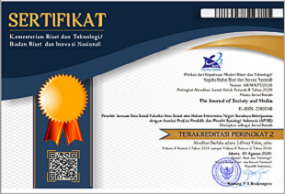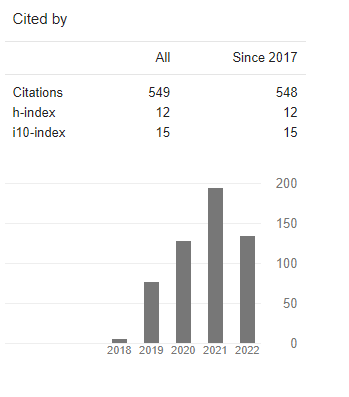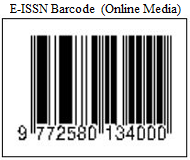Memetakan Publikasi Ilmiah tentang Penggunaan Media Sosial untuk Kampanye Politik
Analisis Bibliometric dengan Bibliometrix R-package
DOI:
https://doi.org/10.26740/jsm.v8n1.p225-254Kata Kunci:
social media, political campaigns, bibliometric analysis, bibliometrixAbstrak
Penelitian ini bertujuan untuk mengetahui perkembangan publikasi ilmiah dalam jurnal dan prosiding konferensi tentang penggunaan media sosial untuk kampanye politik dari tahun 2008 hingga 2023. Penelitian ini menggunakan desain kualitatif untuk pemetaan literatur. Data yang diolah dalam penelitian ini diambil dari database Scopus menggunakan kata kunci Social Media Use for Political Campaigns dari tahun 2008 hingga 2023. Penelitian ini menggunakan Bibliometrix R-package untuk melakukan analisis tren perkembangan publikasi. Selain itu, untuk menyajikan visualisasi pemetaan jaringan dan analisis densitas kata kunci, penelitian ini menggunakan VOSviewer. Temuan mengungkapkan bahwa Amerika Serikat merupakan negara yang paling dominan dalam hal publikasi. Tema ini juga mengalami peningkatan yang signifikan sekitar 83 persen sejak 2011. Information Communication and Society muncul sebagai penerbit paling terkemuka, dan dalam hal afiliasi kelembagaan, University of California memegang jumlah afiliasi tertinggi soal publikasi tema ini. Social Media dan Social Networking (online) muncul sebagai frasa paling populer dari temuan kami. Selain itu, Twitter muncul sebagai platform media sosial yang paling banyak dipelajari. Menariknya, publikasi baru-baru ini mulai mengakomodasi topik ke arah diskusi metodologis dan menguji fenomena terkait menggunakan teknik berbasis komputasi seperti Machine Learning, Natural Language Processing (NLP), dan Affective Computing.
Referensi
Boulianne, S. (2015). Social media use and participation: a meta-analysis of current research. Information Communication and Society, 18(5). https://doi.org/10.1080/1369118X.2015.1008542
Boulianne, S., & Larsson, A. O. (2023). Engagement with candidate posts on Twitter, Instagram, and Facebook during the 2019 election. New Media and Society, 25(1). https://doi.org/10.1177/14614448211009504
de-Oliveira, M., de Almeida, C. M., & Mainardes, E. W. (2022). Politics and social media: an analysis of factors anteceding voting intention. International Review on Public and Nonprofit Marketing, 19(2). https://doi.org/10.1007/s12208-021-00301-7
Dervis, H. (2019). Bibliometric analysis using bibliometrix an R package. Journal of Scientometric Research, 8(3). https://doi.org/10.5530/JSCIRES.8.3.32
Dimitrova, D. V., & Bystrom, D. (2013). The Effects of Social Media on Political Participation and Candidate Image Evaluations in the 2012 Iowa Caucuses. American Behavioral Scientist, 57(11). https://doi.org/10.1177/0002764213489011
Dimitrova, D. V., & Matthes, J. (2018). Social Media in Political Campaigning Around the World: Theoretical and Methodological Challenges. In Journalism and Mass Communication Quarterly (Vol. 95, Issue 2). https://doi.org/10.1177/1077699018770437
Enli, G. (2017). Twitter as arena for the authentic outsider: exploring the social media campaigns of Trump and Clinton in the 2016 US presidential election. European Journal of Communication, 32(1). https://doi.org/10.1177/0267323116682802
Falasca, K., Dymek, M., & Grandien, C. (2019). Social media election campaigning: who is working for whom? A conceptual exploration of digital political labour. Contemporary Social Science, 14(1). https://doi.org/10.1080/21582041.2017.1400089
Farkas, J., & Schou, J. (2023). Post-Truth, Fake News and Democracy: Mapping the Politics of Falsehood, Second Edition. In Post-Truth, Fake News and Democracy: Mapping the Politics of Falsehood, Second Edition. https://doi.org/10.4324/9781003434870
Harris, L., & Harrigan, P. (2015). Social Media in Politics: The Ultimate Voter Engagement Tool or Simply an Echo Chamber? Journal of Political Marketing, 14(3). https://doi.org/10.1080/15377857.2012.693059
Hudders, L., De Jans, S., & De Veirman, M. (2021). The commercialization of social media stars: a literature review and conceptual framework on the strategic use of social media influencers. International Journal of Advertising, 40(3). https://doi.org/10.1080/02650487.2020.1836925
Jennings, F. J., Coker, C. R., McKinney, M. S., & Warner, B. R. (2017). Tweeting Presidential Primary Debates: Debate Processing Through Motivated Twitter Instruction. American Behavioral Scientist, 61(4). https://doi.org/10.1177/0002764217704867
Jim A. Kuypers. (2010). Framing analysis from a rhetorical perspective. Doing News Framing Analysis: Empirical and Theoretical Perspectives, December 2010.
Jungherr, A. (2016). Four Functions of Digital Tools in Election Campaigns: The German Case. International Journal of Press/Politics, 21(3). https://doi.org/10.1177/1940161216642597
Karlsen, R., & Enjolras, B. (2016). Styles of Social Media Campaigning and Influence in a Hybrid Political Communication System. The International Journal of Press/Politics, 21(3). https://doi.org/10.1177/1940161216645335
Kim, Y., & Chen, H. T. (2016). Social media and online political participation: The mediating role of exposure to cross-cutting and like-minded perspectives. Telematics and Informatics, 33(2). https://doi.org/10.1016/j.tele.2015.08.008
Kruikemeier, S., Lecheler, S., & Boyer, M. M. (2018). Learning From News on Different Media Platforms: An Eye-Tracking Experiment. Political Communication, 35(1). https://doi.org/10.1080/10584609.2017.1388310
Lam, S. Y. B., Cheung, M. F. M., & Lo, W. H. (2021). What matters most in the responses to political campaign posts on social media: The candidate, message frame, or message format? Computers in Human Behavior, 121, 106800. https://doi.org/10.1016/J.CHB.2021.106800
Liang, D., De Jong, M., Schraven, D., & Wang, L. (2022). Mapping key features and dimensions of the inclusive city: A systematic bibliometric analysis and literature study. International Journal of Sustainable Development and World Ecology, 29(1). https://doi.org/10.1080/13504509.2021.1911873
Mathaisel, D. F. X., & Comm, C. L. (2021). Political marketing with data analytics. Journal of Marketing Analytics, 9(1). https://doi.org/10.1057/s41270-020-00097-1
McGregor, S. C. (2018). Personalization, social media, and voting: Effects of candidate self-personalization on vote intention. New Media and Society, 20(3). https://doi.org/10.1177/1461444816686103
McLaughlin, B., & Macafee, T. (2019). Becoming a Presidential Candidate: Social Media Following and Politician Identification. Mass Communication and Society, 22(5). https://doi.org/10.1080/15205436.2019.1614196
Mochla, V., Tsourvakas, G., & Stoubos, I. (2023). Segmenting Voters by Motivation to Use Social Media and Their Lifestyle for Political Engagement. Journal of Political Marketing. https://doi.org/10.1080/15377857.2023.2168831
Mochla, V., Tsourvakas, G., & Vlachopoulou, M. (2023). Positioning a Personal Political Brand on YouTube with Points of Different Visual Storytelling. Journal of Political Marketing. https://doi.org/10.1080/15377857.2023.2165214
Munoz, C. L., & Towner, T. (2021). Do high engagement Instagram images influence presidential candidate evaluation? The moderating effect of familiarity. Journal of Research in Interactive Marketing, ahead-of-print(ahead-of-print). https://doi.org/10.1108/JRIM-01-2021-0003/FULL/PDF
Persson, O., Danell, R., & Schneider, J. W. (2009). How to use Bibexcel for various types of bibliometric analysis. Celebrating Scholarly Communication Studies: A Festschrift for Olle Persson at His 60th Birthday.
Priya, & Gupta, S. (2023). Identification of Political Hate Speech Using Machine Learning-Based Text Toxicity Analysis. Lecture Notes in Networks and Systems, 516. https://doi.org/10.1007/978-981-19-5221-0_22
Skoric, M. M., Zhu, Q., Goh, D., & Pang, N. (2016). Social media and citizen engagement: A meta-analytic review. New Media and Society, 18(9). https://doi.org/10.1177/1461444815616221
Spierings, N., & Jacobs, K. (2014). Getting Personal? The Impact of Social Media on Preferential Voting. Political Behavior, 36(1). https://doi.org/10.1007/s11109-013-9228-2
Stromer-Galley, J. (2019). Presidential Campaigning in the Internet Age. In Presidential Campaigning in the Internet Age. https://doi.org/10.1093/oso/9780190694043.001.0001
Subekti, D., Nurmandi, A., & Mutiarin, D. (2022). Mapping Publication Trend of Political Parties Campaign in Social Media: A Bibliometric Analysis. Journal of Political Marketing. https://doi.org/10.1080/15377857.2022.2104424
van Eck, N. J., & Waltman, L. (2014). CitNetExplorer: A new software tool for analyzing and visualizing citation networks. Journal of Informetrics, 8(4). https://doi.org/10.1016/j.joi.2014.07.006
Van Eck, N. J., & Waltman, L. (2019). VOSviwer Manual version 1.6.10. CWTS Meaningful Metrics, January.
von Sikorski, C. (2022). Visual polarisation: Examining the interplay of visual cues and media trust on the evaluation of political candidates. Journalism, 23(9). https://doi.org/10.1177/1464884920987680
Williams, C. B., & Gulati, G. J. J. (2013). Social networks in political campaigns: Facebook and the congressional elections of 2006 and 2008. New Media and Society, 15(1). https://doi.org/10.1177/1461444812457332
Yamamoto, M., & Morey, A. C. (2019). Incidental News Exposure on Social Media: A Campaign Communication Mediation Approach. Social Media and Society, 5(2). https://doi.org/10.1177/2056305119843619
Zhang, W., Johnson, T. J., Seltzer, T., & Bichard, S. L. (2010). The revolution will be networked: The influence of social networking sites on political attitudes and behavior. Social Science Computer Review, 28(1). https://doi.org/10.1177/0894439309335162
Zupic, I., & ?ater, T. (2015). Bibliometric Methods in Management and Organization. Organizational Research Methods, 18(3). https://doi.org/10.1177/1094428114562629
Unduhan
Diterbitkan
Cara Mengutip
Terbitan
Bagian
Lisensi
Hak Cipta (c) 2024 The Journal of Society and Media

Artikel ini berlisensi Creative Commons Attribution 4.0 International License.
 Abstract views: 377
,
Abstract views: 377
, PDF Downloads: 705
PDF Downloads: 705












